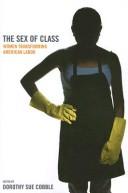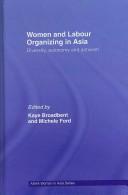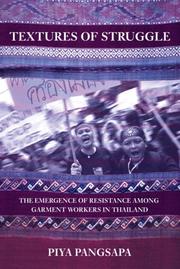| Listing 1 - 9 of 9 |
Sort by
|

ISBN: 9780801443220 0801443229 9780801489433 0801489431 1336207892 0801462487 9780801462481 Year: 2007 Publisher: Ithaca
Abstract | Keywords | Export | Availability | Bookmark
 Loading...
Loading...Choose an application
- Reference Manager
- EndNote
- RefWorks (Direct export to RefWorks)
Women now comprise the majority of the working class. Yet this fundamental transformation has gone largely unnoticed. This book is about how the sex of workers matters in understanding the jobs they do, the problems they face at work, and the new labor movements they are creating in the United States and globally. In The Sex of Class, twenty prominent scholars, labor leaders, and policy analysts look at the implication of this "sexual revolution" for labor policy and practice. The Sex of Class introduces readers to some of the most vibrant and forward-thinking social movements of our era: the clerical worker protests of the 1970's; the emergence of gay rights on the auto shop floor; the upsurge of union organizing in service jobs; worker centers and community unions of immigrant women; successful campaigns for paid family leave and work redesign; and innovative labor NGOs, cross-border alliances, and global labor federations. Revealing the animating ideas and the innovative strategies put into practice by the female leaders of the twenty-first-century social justice movement, the contributors to this book offer new ideas for how government can help reduce class and sex inequalities. They assess the status of women and sexual minorities within the traditional labor movement and they provide inspiring case studies of how women workers and their allies are inventing new forms of worker representation and power.
Women in the labor movement --- Women labor union members --- Women --- Femmes dans le mouvement ouvrier --- Femmes dans les syndicats --- Femmes --- Employment --- Travail --- Women in the labor movement - United States. --- Business & Economics --- Labor & Workers' Economics --- Labor movement

ISBN: 9780415413152 Year: 2007 Publisher: London : Routledge,
Abstract | Keywords | Export | Availability | Bookmark
 Loading...
Loading...Choose an application
- Reference Manager
- EndNote
- RefWorks (Direct export to RefWorks)
Women in the labor movement --- Women labor leaders --- Labor unions --- Femmes dans le mouvement ouvrier --- Dirigeantes syndicales --- Syndicats --- Organizing --- Organisation
Book
ISBN: 0874719429 Year: 1977 Publisher: London : Croom Helm,
Abstract | Keywords | Export | Availability | Bookmark
 Loading...
Loading...Choose an application
- Reference Manager
- EndNote
- RefWorks (Direct export to RefWorks)
Women in politics --- Women in the labor movement --- Women in trade-unions --- History --- Labour Party (Great Britain) --- Women labor union members --- Women --- History. --- Political activity
Book
Year: 2021 Publisher: Éditions du Croquant
Abstract | Keywords | Export | Availability | Bookmark
 Loading...
Loading...Choose an application
- Reference Manager
- EndNote
- RefWorks (Direct export to RefWorks)
Women in the labor movement --- Working class women --- Women labor union members --- Labor movement --- Feminism --- History --- Social conditions --- History --- History --- History
Book
ISBN: 9782895962571 289596257X 2895967261 2895969140 Year: 2018 Publisher: Québec : Lux, editeur,
Abstract | Keywords | Export | Availability | Bookmark
 Loading...
Loading...Choose an application
- Reference Manager
- EndNote
- RefWorks (Direct export to RefWorks)
Dans l'histoire du travail, les femmes ont joué un rôle méconnu, voire ignoré, par la plupart des historiens et sociologues. Quelques historiennes, au cours des dernières décennies se sont employées à pallier ce manque. Se nourrissant de leurs travaux, Rolande Pinard propose ici une analyse sociohistorique de l'activisme des travailleuses ayant contribué, dans le mouvement ouvrier, à élaborer le sens social-politique du travail. Richement documentée, cette recherche soutient que, de leur solidarité initiale avec les travailleurs, les travailleuses ont progressivement été marginalisées dans les formes de syndicalisme qui ont suivi. En bout de ligne, l'émancipation par le travail a quasi exclusivement été le lot des hommes, qui ont bénéficié des institutions (comme le syndicalisme) construites par les luttes ouvrières, sociales et politiques des salarié.e.s.Soulignant l'aspect pluridimensionnel de la formation de la classe ouvrière, Rolande Pinard rappelle que comprendre le travail d'un point de vue critique implique de tenir compte de ses différents agents à travers les périodes historiques de transformation du capitalisme.
Women in the labor movement --- Women labor union members --- Working class women --- Women --- Femmes dans le mouvement ouvrier --- Femmes dans les syndicats --- Femmes de la classe ouvrière --- Femmes --- Women in the labor movement. --- Women labor union members. --- Working class women. --- History --- Employment --- Histoire --- Conditions sociales --- Travail --- Employment. --- 1900-1999
Book
ISBN: 9782365121484 2365121489 Year: 2021 Publisher: Vulaines-sur-Seine Editions du Croquant
Abstract | Keywords | Export | Availability | Bookmark
 Loading...
Loading...Choose an application
- Reference Manager
- EndNote
- RefWorks (Direct export to RefWorks)
Et les papiers avaient volé par la fenêtre… Comme les mecs". C’est ainsi que les ouvrières de l’usine de lingerie Chantelle de la région nantaise parlent de leurs luttes. Alors que la protestation ouvrière prend plus souvent les traits des métallurgistes, ce livre propose d’en explorer le pendant féminin. Comment des ouvrières qu’a priori tout éloigne de l’engagement militant parviennent-elles à se mobiliser collectivement et à s’approprier les codes, les pratiques et les valeurs du militantisme ouvrier ? Qu’en est-il du modèle du militant viril capable d’en découdre et de porter des grèves dures et violentes lorsqu’il est incarné par des femmes ? L’enquête à partir d’archives syndicales et administratives et d’entretiens nous plonge dans l’histoire de ces ouvrières rebelles de Mai-juin 68 à leur « grande grève » de 1981 jusqu’au combat contre la fermeture de l’usine en 1994. Leurs pratiques syndicales quotidiennes, leur rapport au travail et à l’emploi, leurs espoirs et désespoirs éclairent le sens de leurs luttes de « mauvais genre » au fil des changements de conjoncture sociale et politique qui ont marqué l’histoire française des années 1960 aux années 1990.
Working class women --- Women in the labor movement --- Textile industry --- Women textile workers --- Strikes and lockouts --- Travailleuses --- Femmes dans le mouvement ouvrier --- Industries textiles --- Textile industry --- Activité politique --- Grèves et lock-out
Book
Abstract | Keywords | Export | Availability | Bookmark
 Loading...
Loading...Choose an application
- Reference Manager
- EndNote
- RefWorks (Direct export to RefWorks)
Women --- Femmes --- Political activity --- Social conditions --- Activité politique --- Conditions sociales --- 396.5 <44> --- 396.9 <44> --- Women in politics --- -Women in the labor movement --- -Work and family --- -396.5 <44> --- Families and work --- Family and work --- Families --- Dual-career families --- Work-life balance --- Labor movement --- Vrouwenarbeid. Vrouwentewerkstelling. Werkende vrouwen--Frankrijk --- Vrouw en politiek--Frankrijk --- 396.9 <44> Vrouw en politiek--Frankrijk --- 396.5 <44> Vrouwenarbeid. Vrouwentewerkstelling. Werkende vrouwen--Frankrijk --- Activité politique --- Sociology of work --- Political systems --- Public administration --- Community organization --- France --- Women in the labor movement --- Work and family --- Household work --- Participation --- Political participation --- Private sphere --- Division of tasks --- Trade unions --- Book

ISBN: 9780801445910 0801445914 9780801473760 0801473764 080146174X 9780801461743 Year: 2007 Publisher: Ithaca [N.Y.] ILR Press/Cornell University Press
Abstract | Keywords | Export | Availability | Bookmark
 Loading...
Loading...Choose an application
- Reference Manager
- EndNote
- RefWorks (Direct export to RefWorks)
Based on intensive ethnographic fieldwork in Thailand, Textures of Struggle focuses on the experiences of Thai women who are employed at textile factories and examines how the all-encompassing nature of wage work speaks to issues of worker accommodation and resistance within various factory settings. Why are some women less tolerant of their working conditions than others? How is it that women who have similar levels of education, come from the same socioeconomic background, and enter the same occupation, nevertheless emerge with different experiences and reactions to their wage employment?Women in the Thai apparel industry, Piya Pangsapa finds, have very different experiences of labor "militancy" and "non-militancy." Through interviews with women at two kinds of factories-one linked to the global economy through local capital investment and another through transnational capital-Pangsapa examines issues of worker consciousness with a focus on the process by which women become activists.She explores the different degrees of control and coercion employed by factory managers and shows how women were able to overcome conditions of adversity by relying on the close personal ties they developed with each other. Textures of Struggle reveals what it is like for women to feel powerlessness and passivity in Thai sweatshops but also shows how they are equally able to resist and rebel.
Women clothing workers --- Women textile workers --- Women in the labor movement --- Industrial relations --- Travailleuses du vêtement --- Travailleuses du textile --- Femmes dans le mouvement ouvrier --- Relations industrielles --- Case studies. --- Cas, Etudes de --- Etudes de cas --- Travailleuses du vêtement --- Clothing workers --- Textile workers --- Labor movement --- Capital and labor --- Employee-employer relations --- Employer-employee relations --- Labor and capital --- Labor-management relations --- Labor relations --- Employees --- Management
Book
ISBN: 9780190874629 0190874627 019094370X 0190874635 0190874643 Year: 2019 Publisher: New York, NY : Oxford University Press,
Abstract | Keywords | Export | Availability | Bookmark
 Loading...
Loading...Choose an application
- Reference Manager
- EndNote
- RefWorks (Direct export to RefWorks)
Founded in 1919 along with the League of Nations, the International Labour Organization (ILO) establishes labor standards and produces knowledge about the world of work, serving as a forum for nations, unions, and employer associations. Before WWII, it focused on enhancing conditions for male industrial workers in Western, often imperial, economies, while restricting the circumstances of women's labors. Over time, the ILO embraced non-discrimination and equal treatment. It now promotes fair globalization, standardized employment and decent work for women in the developing world. In Making the Woman Worker, Eileen Boris illuminates the ILO's transformation in the context of the long fight for social justice. Boris analyzes three ways in which the ILO has classified the division of labor: between women and men from 1919 to 1958; between women in the global south and the west from 1955 to 1996; and between the earning and care needs of all workers from 1990s to today. Before 1945, the ILO focused on distinguishing feminized labor from male workers, whom the organization prioritized. But when the world needed more women workers, the ILO (a UN agency after WWII) highlighted the global differences in women's work, began to combat sexism in the workplace, and declared care work essential to women's labor participation. Today, the ILO enters its second century with a mission to protect the interests of all workers in the face of increasingly globalized supply chains, the digitization of homework, and cross-border labor trafficking. As Boris shows, the ILO's treatment of women is a window into the modern history of labor. The historic relegation of feminized labor to the part-time, short-term, and low-waged prefigures the future organization of work. The labor force is increasingly self-employed and working as long as possible--a steep price for flexibility--with minimal governmental oversight. How we treat workers in the next century will inevitably build upon evolving ideas of the woman worker, shaped significantly through the ILO.
Women --- Women in the labor movement. --- Sex discrimination in employment --- Women's rights. --- Employment --- History --- Law and legislation. --- International Labour Organization --- History. --- Women in the labor movement --- Women's rights --- Employment&delete& --- Law and legislation --- ILO (International Labour Organization) --- Organisation internationale du travail --- OIT (International Labour Organization) --- Organización Internacional del Trabajo --- Olon Ulsyn Khȯdȯlmȯriĭn Tovchoo --- Olon Ulsyn Khȯdȯlmȯriĭn Baĭguullaga --- OUKhB --- Shirika la Kazi Duniani --- Samnakngān Rǣngngān rawāng Prathēt --- International Labor Organization --- United Nations. --- ʻOngkān Rǣngngān rawāng Prathēt --- International Labour Office --- International Labour Organisation --- Rights of women --- Human rights --- Employment (Economic theory) --- Sex role in the work environment --- Sexual division of labor --- Labor movement --- Human females --- Wimmin --- Woman --- Womon --- Womyn --- Females --- Human beings --- Femininity --- Civil rights --- Legal status, laws, etc. --- Femmes --- Femmes dans le mouvement ouvrier --- Discrimination sexuelle dans l'emploi --- Travail --- Droit --- Histoire. --- Droit. --- Women employees --- Labor laws and legislation --- 1900-2099
| Listing 1 - 9 of 9 |
Sort by
|

 Search
Search Feedback
Feedback About
About Help
Help News
News